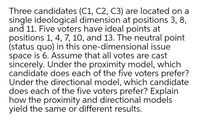Question

Transcribed Image Text:Three candidates (C1, C2, C3) are located on a
single ideological dimension at positions 3, 8,
and 11. Five voters have ideal points at
positions 1, 4, 7, 10, and 13. The neutral point
(status quo) in this one-dimensional issue
space is 6. Assume that all votes are cast
sincerely. Under the proximity model, which
candidate does each of the five voters prefer?
Under the directional model, which candidate
does each of the five voters prefer? Explain
how the proximity and directional models
yield the same or different results.
Expert Solution
This question has been solved!
Explore an expertly crafted, step-by-step solution for a thorough understanding of key concepts.
This is a popular solution
Trending nowThis is a popular solution!
Step by stepSolved in 3 steps
